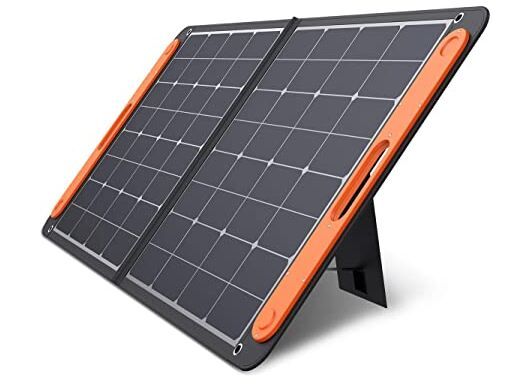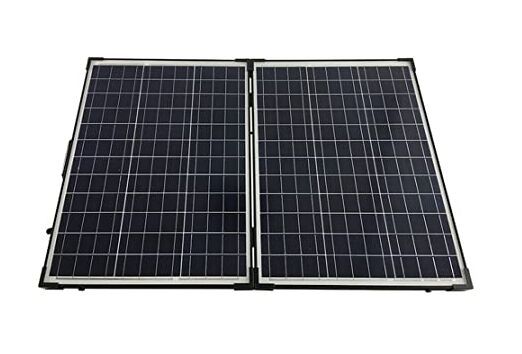Solar panels, also known as photovoltaic panels, are a type of power generation device that generates direct current when exposed to sunlight. It is almost entirely composed of solid photovoltaic cells made of semiconductor materials. The portable foldable solar power generation panel adopts monocrystalline silicon design, with output power up to 100W, high-efficiency power generation efficiency, and cell conversion efficiency up to 20%, which is higher in photoelectric conversion efficiency than general solar panels.
Simple photovoltaic cells can provide energy for watches and computers. More complex photovoltaic systems can provide lighting, traffic lights, and monitoring systems for houses. They can be integrated into the power grid. The photovoltaic panels can be made in different shapes, and the components can be connected to produce more electrical energy.
Since the electricity generated by solar cells is direct current, if you need to provide electricity to household appliances or various electrical appliances, you need to install a direct/AC converter and replace it with alternating current to supply power to household electricity or industrial electricity. The portable foldable solar panel is small in size, foldable design, easy to carry, can be lifted with one hand, placed in a field bracket firmly, with certain wind resistance. In practical applications, folding solar panels can be used in conjunction with portable inverter integrated machines, communication terminals, communication command boxes, etc. to supplement on-site power, alleviating the problem of insufficient power supply of the power receiving device itself.
Solar cells are mainly made of semiconductor materials. When the photoelectric material absorbs light energy to generate a current, photoelectric conversion occurs. A solar cell is a photovoltaic element that converts energy, and its basic structure is formed by joining P-type and N-type semiconductors. The most basic material of a semiconductor is "silicon", which is non-conductive, but if different impurities are doped into the semiconductor, it can be made into P-type and N-type semiconductors, and then the P-type semiconductor has a hole (P-type The semiconductor has one less negatively charged electron, which can be regarded as one more positive charge), and the N-type semiconductor has one more free electron potential difference to generate current, so when the sun shines, the light energy will The electrons are excited, and convection of electrons and holes occurs. These electrons and holes are affected by the built-in potential and are attracted to N-type and P-type semiconductors, respectively, and gather at both ends. At this time, if the outside is connected with electrodes, a loop is formed.
Solar power generation method: light-heat-electricity conversion
The thermal energy generated by solar radiation is generally used to generate heat by solar collectors to convert the absorbed heat energy into working fluid vapor, and then drive the steam turbine to generate electricity. The former process is a light-heat conversion process; the latter process is a heat-electricity conversion process, just like ordinary thermal power generation. It can only be applied to special occasions on a small scale, and large-scale utilization is economically uneconomical and cannot compete with ordinary thermal or nuclear power plants.
Solar power generation method: direct conversion of light to electricity
According to the photoelectric properties of specific materials. The black body radiates electromagnetic waves of different wavelengths (corresponding to different frequencies), such as infrared rays, ultraviolet rays, visible light, and so on. When these rays are irradiated on different conductors or semiconductors, photons interact with free electrons in the conductors or semiconductors to generate electrical current. The shorter the wavelength of the rays and the higher the frequency, the higher the energy they have.
Most existing solar panels have a fixed planar structure and are usually installed outside the door or on the roof of the house. After the solar panel is installed, it is fixed in place and cannot be disassembled. Especially in the case of bad weather or relocation, the solar panel cannot be recycled in time because it is easy to damage the solar panel and cause huge economic losses. For ease of use, there are many foldable solar panels on the market for different applications.

Portable solar panels are simple to use and compact and are ideal for areas where generators are prohibited. The portable solar panel (including USB interface) The design uses a 100-watt module with two panels, the panel has a rear bracket and can be placed on any surface at a 45? angle. The conversion efficiency is as high as 23%, which is one of the highest efficiencies currently available.
The portable solar panel can be moved at will to get the best sunlight. Low operating cost. After purchase, the portable solar panel does not require any operation. The portable solar panel includes two USB output chargers, suitable for charging smartphones and small electronic devices. One of the USB ports is a USB-C (5V/3A) type, and the other is a USB-A (5V/2.4A) port type. It also includes an Anderson connector, whose DC output is 18V and 5.55A, and has overload, Short circuit, and surge protection.
This portable solar panel can even maximize power generation in low light conditions, which means you can still be self-sufficient on cloudy days. Not to mention, they also have adjustable feet, so the panel can be at an angle to the sun and can be easily moved as needed.
Portable folding solar panels are ideal for families using tents on tents without having to connect wires or prepare for the upcoming zombie apocalypse. Once the fixed solution is installed, it can be forgotten.
The off-grid polycrystalline silicon solar suitcase provides a 100W solution integrated by polycrystalline solar panels and is equipped with a suitcase, making it an ideal product for the portable solar market. The device includes a specific temperature sensor that can accurately charge the battery pack. The solar panel has 36 solar cells and an open-circuit voltage of 22 V output.
Available PWM charge controllers have an output of 20 A, can be coupled to 12 V and 24 V battery systems, and 10 feet of wiring to connect the charge controller to the battery(PWM Solar charge controller LS series). The charge controller also includes overvoltage protection, 3 charging stages, and it takes about 2 hours to charge in the boosting stage. You can carry the module with you, because this off-grid polycrystalline silicon solar suitcase is very lightweight, and when you connect the battery, you can use the application throughout the day.
The shape of this solar panel is circular. Since the type of circular solar panel is tailored according to the specific product shape requirements of the customer, the customer needs to install it on the circular surface of the product. There are two types of round solar panels, one is epoxy round solar panels and the other is laminated solar panels. Epoxy round solar panels are cheap and beautiful, which is why many people like it, but their service life is no longer like laminated round solar panels. If you need a small size and small power, and the size is even less than 20mm, then the epoxy round solar panel is an excellent choice for you.
The biggest factor affecting your purchase of portable solar panels should be the utilization rate of solar panels. Of course, if the frequency of water in your environment is very high, then you must choose a portable solar panel with encapsulating materials with good water resistance.
Portable solar panels are devices that need to be changed frequently, so when buying, you should also take into account the weight you can bear. Low-weight portable solar panels can make it easier for you to carry(For more portable solar panels, please check our product page: Inverter & Power Transformer & Solar Panel | Buy Online).
Within the price range, you can afford, choose the most efficient solar panel, use the least solar panel surface area to achieve the best quality performance, and make it produce the greatest efficiency.
Crystal technology is the most popular technology in the on-grid and off-grid markets. This is currently the most efficient material.
Solar energy varies according to various environmental conditions. The value of solar irradiance, shadow, temperature, and the amount of direct sunlight will change the output power of the solar panel and will change the charging speed of the solar charger. Besides, if you want to purchase off-grid marine solar panels, you may use battery packs and charge controllers. Some energy will also be lost during the energy conversion process. Therefore, if you want to charge within a day, you must estimate that the size of the solar panel is slightly higher than the specific requirements.
We must consider that another important fact of solar cells and solar chargers is energy consumption. The difference between power consumption and energy is that power refers to the instantaneous demand of electronic devices, and energy refers to the demand over time. In other words, energy multiplied by power multiplied by usage time and expressed in Wh. A
However, it is also important to know that energy can be expressed in ampere-hours (Ah) because the capacity of most solar cells is expressed in this unit. For unit conversion, we can simply divide the energy in Wh by the voltage.
Benefits of the solar panel charger: It does not require an external power source to charge the battery, does not generate any emissions, waste or by-products, freedom of movement, and environmental friendliness.
Tips for choosing a portable foldable solar panel kit:
The portable foldable solar panel kit provides 12-volt power and can charge 12-volt batteries. They consist of two 12V solar panels hinged together, so they can be folded together when not in use. Their hinge feet are attached to the back of the solar panel, and there is also a small solar regulator with a connected power cord and battery clip. The complete portable solar panel kit is packed in a bag or suitcase.

Dust can seriously affect the performance of portable solar systems because they reduce the amount of light that solar cells can absorb. Especially in the outdoor environment, it is easier to find sand and dust.
The first thing to understand is that the cleaning process is very easy. All you need to do is use a soft brush or sponge dipped in a little water. No need to use detergent, chlorine, or any other type of liquid. The use of cleaning agents may cause certain chemicals to corrode the solar panel and damage the packaging material, and may even cause damage to the solar cell.
To ensure that your portable solar panel can generate electricity for a long time, just add water to the soft brush (avoid using high mineral content water), and then start cleaning the glass surface.
In other valuable cleaning techniques, please avoid using high-pressure water. The solar system on the roof may require hoses for cleaning, but the pressure of the roof solar panel system is different from the pressure of the portable solar panel kit.
Portable folding solar panels must be frequently installed and disassembled. Therefore, providing a simple and comfortable installation process is the basic principle of its design. Simply open the kit, unfold the solar panel, adjust the feet to provide the proper inclination, and then set up the charge controller that is usually already installed at the back and connect the output of the charge controller to the 12 V battery, it is very simple. These foldable solar panels do not require any support other than fixed legs.
Other portable solar panels are designed to be flexible. These components can be easily fixed by using tape and a little Velcro attached to the back of the solar panel. After adding the Velcro to the upper and lower sides of the panel, you can use tape to secure all solar panels to the roof of the RV. You only need to cover all external boundaries of the module and make sure that it does not block any sunlight from the solar cells.